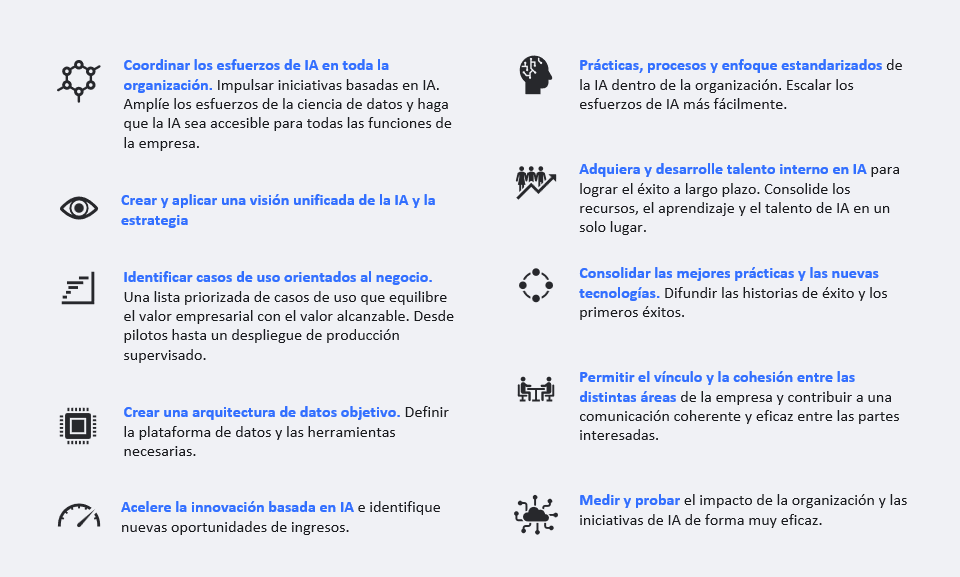Elena Canorea
Communications Lead
Intro
2.Intro
As demand for AI continues to grow in various industries, the evolution and widespread adoption of AI accelerators underscore their crucial role in shaping the future of intelligent computing.
These represent a fundamental breakthrough in artificial intelligence, as they significantly improve the performance and efficiency of workloads. Below, we discuss their features, benefits, and examples.
An AI accelerator is a hardware designed to improve the performance and efficiency of artificial intelligence, deep learning, and machine learning algorithms and applications.
They are capable of performing intensive computations faster and more efficiently than conventional processors and can come in different forms, such as graphics processing cards (GPUs), tensor processing units (TPUs), application-specific integrated circuits (ASICs), or programmable FPGA systems.
The main function of these accelerators is to speed up the processing of ML models and algorithms, enabling faster and more efficient execution. This makes them especially useful in applications where real-time response time is critical, such as speech recognition, image processing, machine translation, autonomous driving, etc.
These accelerators are often used in combination with larger computing systems or infrastructures, such as servers or data centers, to boost performance in AI tasks. In fact, it can also offer specific programming interfaces and tools to facilitate the development and implementation of AI algorithms.

Accelerators are divided into two architectures according to their function: for data centers and edge computing environments. The former requires a highly scalable architecture and large chips, while the latter focuses more on energy efficiency and the ability to deliver near real-time results.
Scale-up integration, or WSI, is a process for building extremely large AI chip networks on a single “super” chip to reduce costs and accelerate the performance of deep learning models.
NPUs are AI accelerators for Deep Learning and neural networks, and the unique data processing requirements of these workloads.
They can process large amounts of data faster than other chips, as well as perform a wide range of AI tasks associated with ML, such as image recognition and the neural networks behind popular applications like ChatGPT.
GPUs are used in a wide variety of devices, including video cards, motherboards, and cell phones.
However, due to their parallel processing capabilities, they are also increasingly used in training AI models.

FPGAs are highly customizable accelerators that rely on specialized expertise to be reprogrammed for a specific purpose.
Unlike other accelerators, they have a unique design that is tailored to a specific function, often having to do with real-time data processing. In addition, they are reprogrammable at the hardware level, which allows for a higher level of customization.
ASIS are designed with a specific purpose or workload in mind, such as deep learning.
Unlike FPGAs, they cannot be reprogrammed, but because they are built with a singular purpose, they tend to perform better than other more general-purpose accelerators.
As the industry expands into new applications and fields, AI accelerators are critical to speed up the data processing needed to create AI applications at scale.
Without AI accelerators, field-programmable gate arrays (FPGAs), and application-specific integrated circuits (ASICs) to accelerate deep learning, advances in AI would take much longer and be more expensive. Therefore, AI accelerators are superior to their older counterparts in three key aspects: speed, efficiency, and design.
Some of their key features include:
As we have explained throughout the article, AI accelerators are a fundamental pillar when it comes to developing and scaling applications using this technology, but, the industry also faces some challenges:

AI accelerators play a crucial role in the development of new applications, be it robotics, satellites, smartphones, computers, etc. Some of the examples of how they are used are:
Accelerators can capture data in near real-time, which makes them fundamental in the development of autonomous cars or drones.
Their parallel processing capabilities are unique, allowing them to process and interpret data from cameras, sensors and process it so that vehicles can react to their environment.
For example, when an autonomous vehicle arrives at a traffic light, the accelerators speed up the processing of sensor data, allowing them to read the traffic signal and the position of other vehicles.
Large language models rely on accelerators to help them develop their ability to understand and generate natural language.
Parallel processing helps speed up processes in neural networks, optimizing the performance of cutting-edge AI applications such as generative AI and chatbots.
Accelerators are critical to the development of the robotics industry due to their ML and machine vision capabilities.
As AI-enhanced robots are developed, accelerators will continue to play a crucial role in developing their capabilities to sense environments and react to them with the same speed and accuracy as human beings.
AI accelerators enable ML tasks to be executed at the edge, rather than moving data to a data center for processing. This reduces latency and energy efficiency in many AI applications.
Many use cases can benefit from an AI accelerator, and one of them is Viawind, a 3D simulation that we have created at Plain Concepts from real photographs and supported by mathematical calculations. The viewer, based on our Evergine graphics engine, anticipates the 3D landscape study, creating ultra-realistic Asset Digital Twin simulations of wind turbines. These digital twins are used to play with the variables and see the visual impact in an online format, which facilitates real-world decision-making.
We take into account all the variables, including the rotations of the windmills according to the best wind perspective, the rotation of the earth, or the key points of the coast so that the visualization is realistic and objective.
It is therefore a 3D simulation that shows the most reliable, realistic, and scientifically rigorous view of what the project will look like and how it will adapt to the environment. In fact, it solves the major problems faced by energy companies when participating in a bidding process:
. 

The key points of improvement in terms of automation and fidelity in the simulation are:
.
At Plain Concepts we have the AI Center of Excellence Accelerator, a unique program that allows you to implement an improvement center to lay a solid foundation and bring out the full potential of AI in your organization. You’ll be able to identify, customize, and strengthen workflows, communications, and patterns to deliver high value at high speed.
We help you create a centralized place where best practices based on knowledge and experience are formulated. We accompany you on this journey, ensuring your governance, standardization, adoption, and operational needs, exposing the power of AI through a seamless experience for business users. In addition, we define policies and models that facilitate corporate-wide adoption of standards and consistent implementation.
Benefits you will find:

At Plain Concepts we help you bridge the gap between executive decision-making and AI implementation through:
All in all, with this accelerator you will gain leadership, best practices, research, support, and training on AI and related topics. As an added bonus, it will be the first step for you to develop new and emerging processes, as well as have in your hands a tool to discover, monitor, and disseminate improved opportunities. What are you waiting for to start your journey?
Elena Canorea
Communications Lead
| Cookie | Duration | Description |
|---|---|---|
| __cfduid | 1 year | The cookie is used by cdn services like CloudFare to identify individual clients behind a shared IP address and apply security settings on a per-client basis. It does not correspond to any user ID in the web application and does not store any personally identifiable information. |
| __cfduid | 29 days 23 hours 59 minutes | The cookie is used by cdn services like CloudFare to identify individual clients behind a shared IP address and apply security settings on a per-client basis. It does not correspond to any user ID in the web application and does not store any personally identifiable information. |
| __cfduid | 1 year | The cookie is used by cdn services like CloudFare to identify individual clients behind a shared IP address and apply security settings on a per-client basis. It does not correspond to any user ID in the web application and does not store any personally identifiable information. |
| __cfduid | 29 days 23 hours 59 minutes | The cookie is used by cdn services like CloudFare to identify individual clients behind a shared IP address and apply security settings on a per-client basis. It does not correspond to any user ID in the web application and does not store any personally identifiable information. |
| _ga | 1 year | This cookie is installed by Google Analytics. The cookie is used to calculate visitor, session, campaign data and keep track of site usage for the site's analytics report. The cookies store information anonymously and assign a randomly generated number to identify unique visitors. |
| _ga | 1 year | This cookie is installed by Google Analytics. The cookie is used to calculate visitor, session, campaign data and keep track of site usage for the site's analytics report. The cookies store information anonymously and assign a randomly generated number to identify unique visitors. |
| _ga | 1 year | This cookie is installed by Google Analytics. The cookie is used to calculate visitor, session, campaign data and keep track of site usage for the site's analytics report. The cookies store information anonymously and assign a randomly generated number to identify unique visitors. |
| _ga | 1 year | This cookie is installed by Google Analytics. The cookie is used to calculate visitor, session, campaign data and keep track of site usage for the site's analytics report. The cookies store information anonymously and assign a randomly generated number to identify unique visitors. |
| _gat_UA-326213-2 | 1 year | No description |
| _gat_UA-326213-2 | 1 year | No description |
| _gat_UA-326213-2 | 1 year | No description |
| _gat_UA-326213-2 | 1 year | No description |
| _gid | 1 year | This cookie is installed by Google Analytics. The cookie is used to store information of how visitors use a website and helps in creating an analytics report of how the wbsite is doing. The data collected including the number visitors, the source where they have come from, and the pages viisted in an anonymous form. |
| _gid | 1 year | This cookie is installed by Google Analytics. The cookie is used to store information of how visitors use a website and helps in creating an analytics report of how the wbsite is doing. The data collected including the number visitors, the source where they have come from, and the pages viisted in an anonymous form. |
| _gid | 1 year | This cookie is installed by Google Analytics. The cookie is used to store information of how visitors use a website and helps in creating an analytics report of how the wbsite is doing. The data collected including the number visitors, the source where they have come from, and the pages viisted in an anonymous form. |
| _gid | 1 year | This cookie is installed by Google Analytics. The cookie is used to store information of how visitors use a website and helps in creating an analytics report of how the wbsite is doing. The data collected including the number visitors, the source where they have come from, and the pages viisted in an anonymous form. |
| attributionCookie | session | No description |
| cookielawinfo-checkbox-analytics | 1 year | Set by the GDPR Cookie Consent plugin, this cookie is used to record the user consent for the cookies in the "Analytics" category . |
| cookielawinfo-checkbox-necessary | 1 year | This cookie is set by GDPR Cookie Consent plugin. The cookies is used to store the user consent for the cookies in the category "Necessary". |
| cookielawinfo-checkbox-necessary | 11 months | This cookie is set by GDPR Cookie Consent plugin. The cookies is used to store the user consent for the cookies in the category "Necessary". |
| cookielawinfo-checkbox-necessary | 11 months | This cookie is set by GDPR Cookie Consent plugin. The cookies is used to store the user consent for the cookies in the category "Necessary". |
| cookielawinfo-checkbox-necessary | 1 year | This cookie is set by GDPR Cookie Consent plugin. The cookies is used to store the user consent for the cookies in the category "Necessary". |
| cookielawinfo-checkbox-non-necessary | 11 months | This cookie is set by GDPR Cookie Consent plugin. The cookies is used to store the user consent for the cookies in the category "Non Necessary". |
| cookielawinfo-checkbox-non-necessary | 11 months | This cookie is set by GDPR Cookie Consent plugin. The cookies is used to store the user consent for the cookies in the category "Non Necessary". |
| cookielawinfo-checkbox-non-necessary | 11 months | This cookie is set by GDPR Cookie Consent plugin. The cookies is used to store the user consent for the cookies in the category "Non Necessary". |
| cookielawinfo-checkbox-non-necessary | 1 year | This cookie is set by GDPR Cookie Consent plugin. The cookies is used to store the user consent for the cookies in the category "Non Necessary". |
| cookielawinfo-checkbox-performance | 1 year | Set by the GDPR Cookie Consent plugin, this cookie is used to store the user consent for cookies in the category "Performance". |
| cppro-ft | 1 year | No description |
| cppro-ft | 7 years 1 months 12 days 23 hours 59 minutes | No description |
| cppro-ft | 7 years 1 months 12 days 23 hours 59 minutes | No description |
| cppro-ft | 1 year | No description |
| cppro-ft-style | 1 year | No description |
| cppro-ft-style | 1 year | No description |
| cppro-ft-style | session | No description |
| cppro-ft-style | session | No description |
| cppro-ft-style-temp | 23 hours 59 minutes | No description |
| cppro-ft-style-temp | 23 hours 59 minutes | No description |
| cppro-ft-style-temp | 23 hours 59 minutes | No description |
| cppro-ft-style-temp | 1 year | No description |
| i18n | 10 years | No description available. |
| IE-jwt | 62 years 6 months 9 days 9 hours | No description |
| IE-LANG_CODE | 62 years 6 months 9 days 9 hours | No description |
| IE-set_country | 62 years 6 months 9 days 9 hours | No description |
| JSESSIONID | session | The JSESSIONID cookie is used by New Relic to store a session identifier so that New Relic can monitor session counts for an application. |
| viewed_cookie_policy | 11 months | The cookie is set by the GDPR Cookie Consent plugin and is used to store whether or not user has consented to the use of cookies. It does not store any personal data. |
| viewed_cookie_policy | 1 year | The cookie is set by the GDPR Cookie Consent plugin and is used to store whether or not user has consented to the use of cookies. It does not store any personal data. |
| viewed_cookie_policy | 1 year | The cookie is set by the GDPR Cookie Consent plugin and is used to store whether or not user has consented to the use of cookies. It does not store any personal data. |
| viewed_cookie_policy | 11 months | The cookie is set by the GDPR Cookie Consent plugin and is used to store whether or not user has consented to the use of cookies. It does not store any personal data. |
| VISITOR_INFO1_LIVE | 5 months 27 days | A cookie set by YouTube to measure bandwidth that determines whether the user gets the new or old player interface. |
| wmc | 9 years 11 months 30 days 11 hours 59 minutes | No description |
| Cookie | Duration | Description |
|---|---|---|
| __cf_bm | 30 minutes | This cookie, set by Cloudflare, is used to support Cloudflare Bot Management. |
| sp_landing | 1 day | The sp_landing is set by Spotify to implement audio content from Spotify on the website and also registers information on user interaction related to the audio content. |
| sp_t | 1 year | The sp_t cookie is set by Spotify to implement audio content from Spotify on the website and also registers information on user interaction related to the audio content. |
| Cookie | Duration | Description |
|---|---|---|
| _hjAbsoluteSessionInProgress | 1 year | No description |
| _hjAbsoluteSessionInProgress | 1 year | No description |
| _hjAbsoluteSessionInProgress | 1 year | No description |
| _hjAbsoluteSessionInProgress | 1 year | No description |
| _hjFirstSeen | 29 minutes | No description |
| _hjFirstSeen | 29 minutes | No description |
| _hjFirstSeen | 29 minutes | No description |
| _hjFirstSeen | 1 year | No description |
| _hjid | 11 months 29 days 23 hours 59 minutes | This cookie is set by Hotjar. This cookie is set when the customer first lands on a page with the Hotjar script. It is used to persist the random user ID, unique to that site on the browser. This ensures that behavior in subsequent visits to the same site will be attributed to the same user ID. |
| _hjid | 11 months 29 days 23 hours 59 minutes | This cookie is set by Hotjar. This cookie is set when the customer first lands on a page with the Hotjar script. It is used to persist the random user ID, unique to that site on the browser. This ensures that behavior in subsequent visits to the same site will be attributed to the same user ID. |
| _hjid | 1 year | This cookie is set by Hotjar. This cookie is set when the customer first lands on a page with the Hotjar script. It is used to persist the random user ID, unique to that site on the browser. This ensures that behavior in subsequent visits to the same site will be attributed to the same user ID. |
| _hjid | 1 year | This cookie is set by Hotjar. This cookie is set when the customer first lands on a page with the Hotjar script. It is used to persist the random user ID, unique to that site on the browser. This ensures that behavior in subsequent visits to the same site will be attributed to the same user ID. |
| _hjIncludedInPageviewSample | 1 year | No description |
| _hjIncludedInPageviewSample | 1 year | No description |
| _hjIncludedInPageviewSample | 1 year | No description |
| _hjIncludedInPageviewSample | 1 year | No description |
| _hjSession_1776154 | session | No description |
| _hjSessionUser_1776154 | session | No description |
| _hjTLDTest | 1 year | No description |
| _hjTLDTest | 1 year | No description |
| _hjTLDTest | session | No description |
| _hjTLDTest | session | No description |
| _lfa_test_cookie_stored | past | No description |
| Cookie | Duration | Description |
|---|---|---|
| loglevel | never | No description available. |
| prism_90878714 | 1 month | No description |
| redirectFacebook | 2 minutes | No description |
| YSC | session | YSC cookie is set by Youtube and is used to track the views of embedded videos on Youtube pages. |
| yt-remote-connected-devices | never | YouTube sets this cookie to store the video preferences of the user using embedded YouTube video. |
| yt-remote-device-id | never | YouTube sets this cookie to store the video preferences of the user using embedded YouTube video. |
| yt.innertube::nextId | never | This cookie, set by YouTube, registers a unique ID to store data on what videos from YouTube the user has seen. |
| yt.innertube::requests | never | This cookie, set by YouTube, registers a unique ID to store data on what videos from YouTube the user has seen. |
